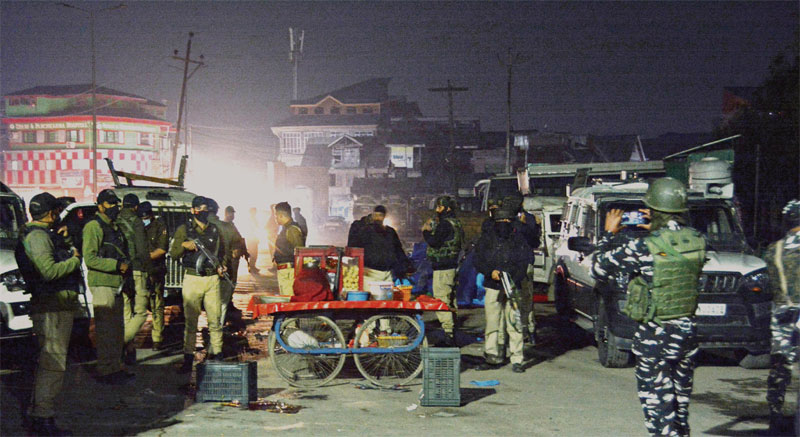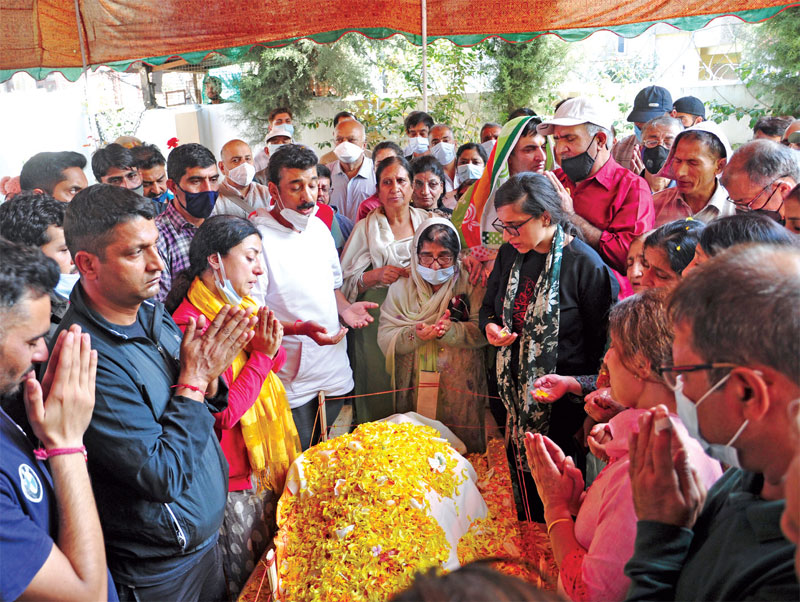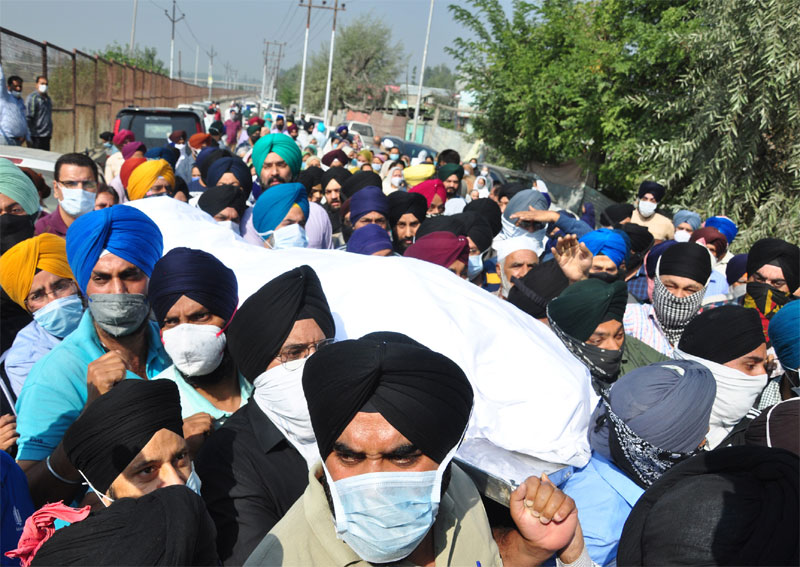A perfect storm is brewing in Kashmir, feeding on reasons both internal and external
Anuradha Bhasin
Before union home minister Amit Shah began his three-day tour to Jammu & Kashmir on an unusually freezing cold autumn day (October 23), the security grid went on an overdrive to sanitise Kashmir. Among a slew of measures were switching off some internet towers and seizing two-wheelers from Srinagar’s roads. No reasons were given. The perplexed vehicle owners were asked to collect their scooters and bikes from police stations after unspecified ‘few days’.

The scooter seizing operation has a precursor. Sometime in the winter of 2020, months after abrogation, a news report mentioned allegations by some people from South Kashmir that their four-wheeled vehicles were being taken away by police in midnight swoop from their homes and returned a few days later. The reports disappeared but activists based in South Kashmir say, on conditions of anonymity, that the practice is now a norm. It is almost a regular story. A lone driver on the road is more likely to be vulnerable and sometimes vehicles are seized from garages inside people’s homes. When the owners are asked to collect them from police stations or security camps, they find them in dusty condition. The aim and purpose of such measures is not known but they are exacerbating the sense of dis-empowerment and helplessness of the public. Such stories, however, rarely make it to the national media.
The dominant narrative in Kashmir during October, preceding Amit Shah’s visit, was the spate in civilian killings, mostly of minorities and migrant workers. 32 civilians were gunned down by suspected militants in Kashmir in 2021, 11 of them in October—two Kashmiri Pandits, a Sikh woman and five migrant workers—revealing an evident pattern of selective targeting. The most distinct signal came on October 7 when masked militants entered a school in Srinagar, scrutinized identity cards of all teachers, singled out Satinder Kaur and Deepak Kumar and shot them in cold blood.
The signs had been visible for some time. In the last several months, civilians and unarmed policemen were increasingly becoming targets of the militants who in recent years had focussed only on targeting security pickets and camps. On September 17, a Kashmiri Pandit railway constable, Bantu Sharma, was killed while he was on his way home in Kulgam district, in broad daylight. Later that day, in the same district, a Bihari labourer, Shankar Kumar Choudhary, was shot dead. That militancy was going out of hands and could come to this point of selective targeting of Kashmir’s religious minorities and non-residents (Muslims included) was already being anticipated.
In the aftermath of the killings, Kashmir is a landscape of panic and repression. About 2,000-3,000 Kashmiri Pandit migrants who had returned as part of Prime Minister’s Relief and Rehabilitation package between 2005 and 2017 fled in a huff to Jammu after October 7 killings. In subsequent weeks, security agencies and the state apparatus carried out busloads of migrant labourers outside Kashmir, cocooned non-migrant Kashmiri Pandits in securitised ghettos and accelerated the crackdown on the Valley’s Muslims with enhanced frisking operations, raids, seizing of two wheelers, detentions, arrests et al.
On 5 August 2019, the Indian government began scripting the story of ‘Naya Kashmir’ with the J&K Reorganisation Act which dismembered the erstwhile state into two union territories and robbed the region of its special status while the population within was put under a spell of curbs. The nation was told that Article 370 was the only impediment to peace, development and communal harmony and the Modi government would usher in an era of peace and development. Subsequent laws, strong armed and intimidatory tactics have helped the government subjugate an entire population into compliance and control the narrative by gagging the media and all forms of dissent in the last two years. The spate in civilian killings coinciding with a massive gunfight between militants and security forces in the sensitive border districts of Rajouri and Poonch, resulting in the death of 9 soldiers, however, reveals that the Valley’s silence is only ephemeral and that things really are not going as per the script. Today, the government is just as clueless as an ordinary civilian about what is happening.
Militant groups like The Resistance Force (TRF), which the police say is a front of Lashkar-e-Taiyyaba (LeT), Islamic State of J&K (ISJK) and an even lesser known Geelani Force have claimed responsibility for some of the killings and criticised each other for making false claims. The truth about violent incidents in Kashmir has always been a casualty to claims, counter claims and lack of scientific probes in the last three decades. The presence of murky and faceless organisations like TRF, ISJK, and GF of the present day further add to the confusion amidst the lack of clear demarcation of boundaries in the insurgency and counter insurgency operations. The whodunnit conundrum remains as alive as the memory of any gory incident of violence. People tend to believe what they want to.
But this is one time, when across the political and religious spectrums, people are talking less about the theory of genesis of the attacks and more about their consequences. Almost everybody, even those who love to cling on to a good conspiracy theory, agrees that 5 August 2019 move and subsequent excessive repression in Kashmir are major enablers for a violent articulation of the deepening resentment and distress over tyranny and ruthless ways of disenfranchising and disempowering the local population.
Since 2019, militarisation and suppression of the Kashmiri Muslims through arrests, intimidations, arbitrary detentions, termination of employees etc has become the norm. The land and development related laws induce threats of demographic influx and arbitrary evacuations without accountability. While the government contends that people are happy and satisfied with the political, geographical and administrative changes made post 2019, the daily tyranny reveals the reality of a Kafka land.

Satish Mahaldar, chairman of the Reconciliation Return & Rehabilitations of Migrants, says that Kashmir’s distressful situation was already a breeding ground for communal backlash and points out that the latest trigger is the hurried implementation of the J&K Kashmiri Migrant Property Act. Many of the Pandit properties were cases of distress sales but the sale deeds were duly executed, and the properties were bought by Muslims. “Of course, there are some cases of encroachment, but hundreds of grievances are being received by the portal on a daily basis since September 2021 and within weeks the government has seized the properties in some cases,” Mahaldar says, adding that these are evoking fear among Muslims that the lands they bought would be seized without any verification.
Altaf Khan, a senior lawyer, avers that the new notification of the J&K Kashmiri Migrant Property Act itself is flawed. It empowers the district administration to immediately seize the property after any complaint has been filed on the grievance portal, which has already received hundreds of complaints. Officers admit that more than 90 per cent claims being made are false but Khan says that seizing property first and then probing each case is designed to dispossess and harass the Muslims who already feel threatened by amendments to several other land related laws.
Added to this are the geostrategic triggers compelled by the emerging Afghanistan situation, its impact in the region, the new global alignments and the missing Indian presence in the diplomatic equation. The actual repercussions of these external factors are yet to be felt but the timing of the recent killings and the Rajouri-Poonch gunfight suggests that the armed rebels are emboldened psychologically. Security officials blame the new trends in insurgency on load of arms delivered by drones or ad hoc pistol carrying militants who are not on the radar. What they miss out is the repressive climate of Kashmir, the arrogant bureaucracy, side-lining of local officials, increasing gap between the officials and the ordinary public leading to break-down of intelligence inputs.
The recent trends in Kashmir ring alarm bells about the major challenges before India—both in Kashmir and on its borders. Within Kashmir, the bruised population is now threatened by ruptures in its communal harmony and the economic fallout of the attacks on migrant labour force.
Kashmiri Pandit migrant employees and their family members who fled to Jammu are terrified and unwilling to go back to the Valley. One of them, teaching in a school in the Valley since the last one decade, said, “Before these killings I felt secure because my Muslim neighbours were very supportive and so were my colleagues. But what security can they provide if militants come barging inside schools and homes and kill you because of your religious identity?”
While the non-migrant Pandits are staying put in the Valley, many of them feel psychologically and even physically uprooted as many of those deemed vulnerable by the administration were shifted to a safe zone. On October 13, when I spoke to Sanjay Tickoo, president of the Kashmiri Pandit Sangharsh Samiti (KPSS), he said, “What do I say where I am,” in a heavy voice betraying sadness, if not fear. He said that post August 2019, the vulnerability of the minorities, already reeling under economic distress, was increasing and “We had time and again reminded the government about this”. Last year, Tickoo and some other KPSS members had launched a hunger strike to demand financial assistance and extension of rehabilitation package for the 808 non-migrant families. But not only are the demands still pending, his recent letters to the Governor since June 2021, highlighting security issues, also went unheeded.
The 1.5 lakh Sikhs, who comprise about two per cent of the Valley’s total population and are spread across the various districts of the Valley, feel equally insecure. Sikh activists feel that the motives were not only to divide people communally but also to instil fear in the minds of the minorities. “Earlier, both the Hurriyat and mainstream leaders would vociferously condemn such incidents and assured security to the minorities,” says Jagmohan Singh Raina, social and political activist. Today, he laments that the political space has diminished, and the civil society is too scared to come out.
“Though a sizeable number of Muslims did appear at the cremation grounds and there was wide-spread condemnation through statements and on social-media, the evolving situation today demanded more than token presence. We need their enmasse physical presence and display of equal anguish with protests and bandhs,” Tickoo says, averring that the “vast majority is still in silent mode”. He is quick to add, “The announcements for maintaining communal harmony and protecting the minorities from some mosques was good. But it should have been more than just nine mosques.” According to him, in the 1990s, a positive response from the Muslims collectively could have stopped the exodus but at that time both sides were caught unawares by the wave of militancy that suddenly fell on Kashmir. “Today, we both know what the consequences are,” he says.
The minority activists, however, are aware that both the political vacuum and the immense repression of the majority community disables a suitable response from the latter. “Who is secure in the Valley today?” Raina asks.
“The majority is not just scared but also resentful of the state’s actions,” Mahaldar adds. Pointing to the shutting of the main mosques for public prayers on Fridays for the last 12 weeks, he says, “They are pushed to the wall.”
A Muslim civil society activist, who did not want to be named, said that they have been trying to reach out to the minorities and giving them assurances but adds, “Our assurances lack conviction. The truth is that we don’t know how safe we are today.” A young student who speaks about random crackdowns in the rural areas says, “Home is the safest space for anyone. But where does that safety valve exist for us when security forces can barge into our house, check our most personal belongings, thrash and abuse us, even detain some of us. Today, we feel completely powerless in our own homes.”
Khan alludes to not just military repression but also collapse of institutions that should be guardians of peoples’ rights. There is also a systemic policy to uproot, displace and dispossess Muslims economically through opening jobs and contracts for outsiders and amending land laws, leading to chaos, confusion and panic, he adds. This suppression explains for both the lack of loud display of angst by the majority over the minority killings and the reason behind the recent attacks, he says. Khan adds that a resonating collective majority response is missing not only because of an element of fear but also because of lack of motivation. He says that unlike the 1990s, bitterness, mistrust and hatred is consuming the minds of many among the majority and blames the acute suppression by the government. They also see themselves as the biggest victims in the emerging situation.
It is not difficult to understand why.
After the two teachers were killed in Srinagar on October 7, a poor Muslim Gujjar, Parvez Ahmed, was shot dead by security forces and his body hurriedly buried without the family’s consent. Officials said, the man was killed ‘in self-defence’ for ‘jumping a checkpoint’ while driving an SUV in the dead of the night. Questions are being asked, whether the killing, which was avoidable, was ‘retaliatory’. In the aftermath of October 7, there has been a spike in random arrests, crackdowns and summons by the police. Reports indicate that at least 900 people were picked up in the first week alone. Among those detained are five journalists. On October 24, 20-year-old Shahid was shot dead in Zainapora, Shopian. Officials say he was killed in cross-firing but the family points to circumstances, alleging targeted killing by CRPF personnel. Such stories, mired in controversy, are a routine in Kashmir.

Reign of Fear
When communal harmony is threatened, as a rule the onus is on the majority community to stick its neck out and speak up vociferously against hatred and violence. Aware that the police cannot assure each one of the protection they need, the minorities of Kashmir have genuine expectations from the majority. The problem, however, is that in a militarised setting, where the majority lives under the constant fear and dread of being killed, tortured or landing up in jail, the interplay of majority and minority dynamics assumes a different hue. The Indian state that should be protecting the rights of the people is on the overdrive of crushing and killing the very spirit of 98 per cent population of the Valley, engendering the silence of abject surrender. The only thing that is now breaking the deafening silence is the gun that is driven by sheer load of bitterness and hatred.
Kashmir’s majority population sees the Indian state, in its avatar of Hindutva, obliterating the distinction between terrorism, Muslim, Enemy—in and outside Kashmir. This has the tendency of evoking an equal and opposite reaction with lines between Hindu, Hindutva and RSS agent getting blurred, particularly among the young impregnable minds. The more the state’s agencies opt for stringent collective punishment methodologies against Kashmir’s Muslims, the worse would be the outcome.
All communities of Kashmir today understand these underlying complexities. The only one losing the plot is the government. It tends to skirt the bloodshed of the majority community and views every incident of minority killing and encounters with militants in terms of simple binaries and thus, continues to resort to knee-jerk reactions that are likely to give a fillip to militancy that could soon have the potential of transcending the territories of this jinxed land.
Whether Pakistan gets to play high stakes in Taliban-controlled Afghanistan or is challenged by Taliban moving southwards, a natural fallout would be pushing armed insurgents across the Line of Control where a tyrannised population is turning hostile. Throw in the China factor and one can clearly see that India is playing with fire that may go completely beyond control unless the government takes a pause and rethinks its strategies with respect to both the geopolitical situation and the internal situation of Kashmir.
(The author is executive editor, Kashmir Times)

